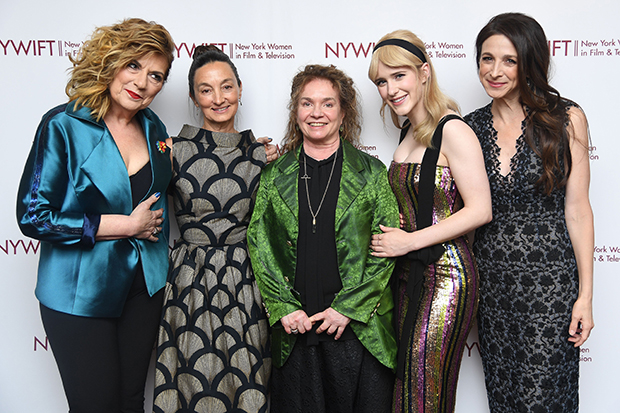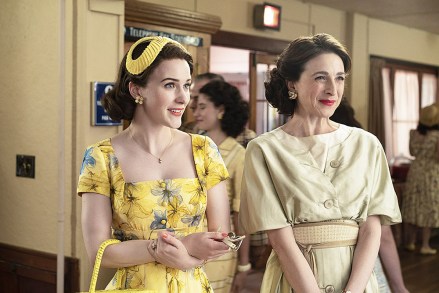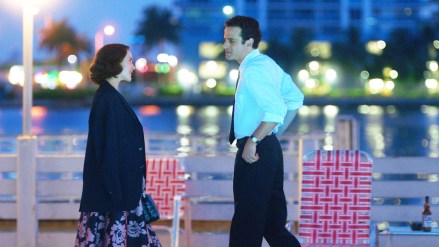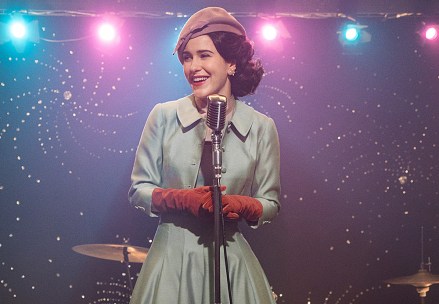
Miriam ‘Midge’ Maisel [Rachel Brosnahan] brightens up the streets of the Upper West Side in the 1950s, and it’s all thanks to the incredibly talented, Emmy nominated costume designer on the hit series, Donna Zakowska. Following the major success of season 1, and recognition of Midge’s impeccable style, Donna brought viewers on a fashion journey, from post-war Paris to the refreshing and playful Catskills. “I really wanted to capture a more of Midge’s buoyant spirit this season,” Donna explained in an EXCLUSIVE interview with HollywoodLife. “[Because we entered in spring,] it really gave me the opportunity to deal with transparencies and seeing pattens and colors through pattern, and do that layering that I really love doing. That didn’t make as much sense in the beginning, when we were much more in fall and winter and it became more about color blocks and wearing colors together.” Donna, who is Emmy nominated in the Best Period Costumes category for the second year in a row, explained more of her inspiration behind Marvelous Mrs. Maisel’s season 2 looks in an exclusive interview with HL!
HollywoodLife: We go from New York City, to Paris, to the Catskills. How important was it for you to show the styles of these different locations during this time period, through the fashion choices made for Midge and her family?
Donna Zakowska: Well, I think there’s really a big gap in this period between Europe and America. Post-war Europe didn’t recover quite as well, and also, they didn’t use color in the same way. So, it was really a little bit darker, and there wasn’t this sort of lightness of spirit that began to characterize American clothing, post-war in the ’50s, so it was very important to me that when you were in Paris, that it was very specific and had the sense of that world. Then, of course, the Catskills being the most contrasting of where we could be, because it really was the urban play land in a lot ways: that’s where people went to enjoy themselves and to escape the city. It really was a little bit more of a heavier darkness versus a set of lightness, in the way of those two very different worlds.
HL: In the Catskills, we saw Midge play with pattern in a way we never have before. How did you come to that decision?
DZ: I think the thing is because we entered spring, and then, especially in the Catskills, like in the yellow dress and a few other things, I really wanted to capture a more of Midge’s buoyant spirit this season. It really gave me the opportunity also to deal with transparencies and seeing pattens and colors through pattern, and do that layering that I really love doing, which didn’t make as much sense in the beginning, when we were much more in fall and winter and it became more about color blocks, and wearing colors together. It was refreshing to suddenly be able to escape the wools and heavy fabrics and really go into lightweight silk and cotton and more whimsical sort of approach to the clothes.
HL: There wasn’t a major time jump between season one and season two, but how, if at all, did you show the progression of fashion during this time period?
DZ: I think it’s been subtle. In season three, we’re not that far ahead but we are a little bit ahead, I think that what you will notice is that when we’re in the earlier part of the ’50s or mid, the skirts are fuller and there is a different structure to the garments. In a very subtle way, the fullness of the clothes is becoming a little bit less, the sleeves have a little bit more width to them. There’s certain elements that are signaling where we’re approaching in terms of the ’60s. I always hate when I see suddenly costumes that change very radically, in a very short period of time. Sometimes I think you lose the character. I mean the ’60s don’t really hit the ’60s in a big way until like ’62 or ’63. But up until that point you’re constantly just transitioning, basically.
HL: Abe’s Romper was a big talk of the season. Tell me about what the inspiration behind that was? And I would love to know what it was like getting Tony Shalhoub into that thing?
DZ: It’s always a delight to get Tony Shalhoub into any garment! As you can see, he so went with it. He just completely improvised those crazy movements! It wasn’t in that period the same sort of vocabulary of sports clothing the way they are now: workout, go to the gym clothing. But, there were a few images that came from television at the time, one of them being Jack LaLanne, which is someone who I used as the inspiration. In a way, he really looked like a French mime, but he was actually one of the first American exercise gurus, and he always wore this jumpsuit, and what I loved is he always had like ballet shoes on, or little jazz shoes. It was a strange combination of mime, dance, hitting the gym. It was really great.
HL: How exactly do you show character development through style?
DZ: I think the thing is, particularly when you get to men’s clothing, there is absolute coding. And, in that period again, unlike now, if you didn’t wear shirt and a tie and a suit, you were other than, or you were Bohemian, or you were on the outside in some way. Now Abe was a Columbia professor so, yes of course he wore those things but it had more of an academic feeling, but it still was very acceptable in the structure of his job. And when you start to feel like the character’s changing, or he’s making different life choices, by abandoning what I call ‘the code,’ that’s how you begin to sort of sense that, “Oh, something’s going on.” And he’s asserting his character in a different way. It’s very clear with men, even much more so than women in terms of how clothing is codified.

HL: When it comes to dressing Marin as Rose, how much do you want her character to contrast or even align with Miriam?
DZ: I don’t really think of them as aligning. I think for Rose, we saw her in season one in her little Chanel suits and she’s very much in her comfortable world, then we see her break away in Paris, and I’ve hoped and tried to have a little bit to a remnant of that quality of her being what I call a more’ American: a little bit avant garde, like the Claire McCardell’s and designers who had a looser feeling, and a more artistic feeling about the way women’s clothing was done. In a subtle way, she never turned back. She always then became a little bit outside of that “mother in a Chanel suit.” Her character absolutely evolves. She was at her high point of carving her own path in Paris, but then coming back from Paris we had to find a way of mixing the Paris experience into Rose’s life. That was a challenge for me.
HL: Do you think Midge’s style will ever rub off on Susie [Alex Borstein]?
DZ: I guess the fact that she gets a jacket this season is as exciting as it gets with her! I think there’s a little bit more of neatness about the way she looks. She’s still. financially, is not in a position to be really be flashy. I think she’ll become a little bit, by wearing the jackets… Not really an Annie Liebovitz type of a look, but sort of like that — a little more tougher, but minimalist. I think that’s about as far as she goes.
HL: How did you decide a jacket was the way to do that?
DZ: In a way, a jacket is a structured garment. Susie has to be able to present herself as a manager. So, inevitably I think when women, still even now, but certainly ’50s, ’60s, ’70s, felt they had to be in the business world and tangling with men, the a jacket, or some sort of suit, the classic pant suit, was the choice. It’s armor: it’s a jacket, it’s armor. I think that made her a little bit tougher in way to be able to go into man’s world and be able to deal with it.
Make sure to tune into the Emmy Awards on September 22 at 8 PM ET on FOX.


